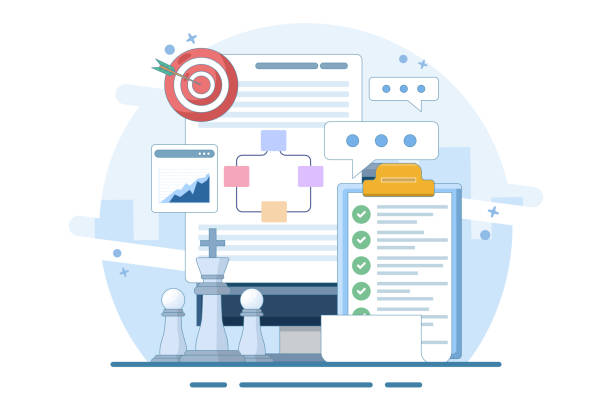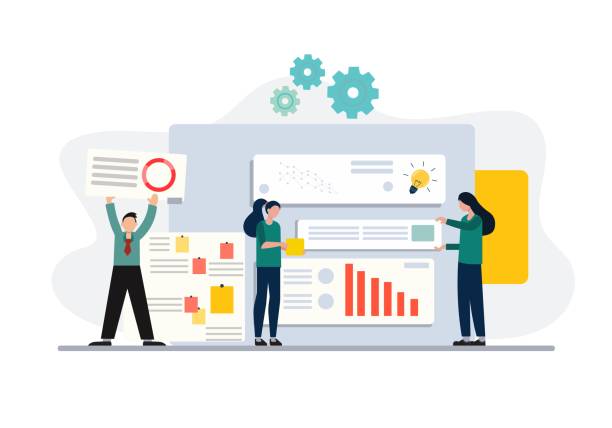The Critical Importance of Secure Website Design in Today’s World

In the current digital age, where more businesses are migrating online every day and digital interactions are becoming more widespread, the concept of secure website design is no longer a luxury option, but a vital necessity.
Website security not only protects your users’ and business’s sensitive information but also directly impacts #user_trust and your brand’s credibility.
A successful cyberattack can lead to #data_breaches, massive financial losses, and loss of reputation, which will be very difficult or even impossible to compensate.
For this reason, investing in secure website design and adhering to its principles from the earliest stages of development is fundamental.
The main goal of #website_security is to protect the confidentiality, integrity, and availability of information.
These three principles, known as the CIA triad, form the backbone of any security strategy.
Confidentiality means ensuring that only authorized individuals have access to information; integrity means maintaining the accuracy and completeness of data and preventing unauthorized changes; and availability means ensuring that authorized users can always access the services and information they need.
Without these three principles, your digital infrastructure will be at serious risk.
Therefore, learning and implementing advanced techniques in secure website design is an ongoing task for developers and website administrators.
This proactive approach protects your business against emerging threats and provides the foundation for a sustainable and successful #online_business.
Did you know that a weak corporate website loses you many opportunities daily? Solve this problem forever with professional corporate website design by RasaWeb!
✅ Creating a powerful and trustworthy image for your brand
✅ Targeted attraction of new customers and sales increase
⚡ [Get Free Website Design Consultation]
Identifying and Countering Common Web Security Threats

To properly perform secure website design, we must first be familiar with the most common security threats that websites face.
Understanding these #security_vulnerabilities is the first step to effective protection.
One of the most common attacks is SQL Injection, where an attacker injects malicious SQL codes through input fields into the database to access or modify sensitive information.
Another attack, #XSS (Cross-Site Scripting), allows an attacker to inject client-side code into web pages and thereby access cookies, session information, or other data.
#DDoS_attacks (Distributed Denial of Service) are another type of threat that render the server unavailable by flooding it with massive traffic, causing service disruption.
#Malware and phishing are also common tools for attackers to steal information or control systems.
Social engineering, especially phishing, remains one of the most effective ways to penetrate systems, as it focuses on human weaknesses rather than technical ones.
To counter these threats in the secure website design process, one must use strict input validation, Web Application Firewalls (WAFs), regular updates of systems and software, and also educate users to detect phishing attacks.
A deep understanding of these threats and countermeasures is essential for anyone looking to enhance their website’s security.
Implementing Fundamental Principles in Secure Website Design

To achieve secure website design, fundamental principles must be implemented from the outset of the software development lifecycle.
One of the most important of these principles is Strict Input Validation.
Any data received from the user must be carefully checked and sanitized to prevent the injection of malicious code or unauthorized data.
This includes validating the type, format, and size of the data.
Additionally, the use of #Prepared_Statements or #Parameterized_Queries in database interactions is highly resistant to SQL injection attacks, as it separates data from SQL commands.
| Security Principle | Description |
|---|---|
| Input Validation | Reviewing and sanitizing all user input data to prevent attacks. |
| Strong Authentication | Using complex passwords, two-factor authentication. |
| Secure Session Management | Using secure tokens, regular session expiration. |
| Data Encryption | Protecting sensitive data in transit and at rest. |
Strong authentication and secure session management are other important pillars.
Passwords should be hashed and salted, and #Multi-Factor_Authentication (MFA) methods should be used for an additional layer of security.
Also, session tokens must be secure, have an expiration time, and be protected against session hijacking.
Data encryption, both in transit (using HTTPS) and at rest (for sensitive information), is mandatory.
These measures, along with secure coding and regular updates of libraries and frameworks, lay the foundation for a stable secure website design.
Each of these measures, while not sufficient on its own, together creates a powerful defensive system.
The Key Role of SSL/TLS Certificates in Web Security

In the discussion of secure website design, the critical importance of SSL/TLS certificates cannot be overlooked.
These certificates, which are activated by the HTTPS protocol on your website, ensure that the communication between the user’s browser and the website server is encrypted and secure.
This encryption prevents eavesdropping, data manipulation, and identity spoofing, assuring users that their information, such as passwords, credit card numbers, and personal data, remains secure during transmission.
The presence of an SSL/TLS certificate is not only a security necessity but also directly impacts your website’s SEO and ranking in search engines.
Google and other search engines rank websites that use HTTPS higher in search results.
There are various types of SSL/TLS certificates, including Domain Validated (DV), Organization Validated (OV), and Extended Validation (EV), each offering different levels of validation and trust.
For #e-commerce websites and sites that process sensitive information, OV and EV certificates, which also verify the organization’s identity, are recommended.
Proper implementation of SSL/TLS is an integral part of secure website design and greatly contributes to increasing #digital_trust among users, as the green bar and lock icon in the browser’s address bar are clear indicators of security for your website visitors.
This action is one of the simplest yet most effective steps to enhance your website’s security.
Does your current website display your brand’s credibility as it should? Or does it scare away potential customers?
RasaWeb, with years of experience in professional corporate website design, is your comprehensive solution.
✅ Modern, beautiful website tailored to your brand identity
✅ Significant increase in lead and new customer acquisition
⚡ Contact RasaWeb now for a free corporate website design consultation!
Continuous Maintenance and Updates for Sustainable Secure Website Design

Secure website design is not a one-time process; it requires continuous maintenance and updates.
Given the rapid pace of developments in cyber threats, every website must be regularly reviewed and updated to protect against new vulnerabilities.
This includes updating the Content Management System (CMS) like WordPress or Joomla, plugins, themes, and all third-party libraries and frameworks used.
Many successful website attacks occur by exploiting #known_vulnerabilities in outdated software for which #security_patches have been released but not installed by website administrators.
In addition to software updates, #site_monitoring and server logs are also very important.
This allows you to identify suspicious activities and react quickly to them.
Using security monitoring tools and Intrusion Detection Systems (IDS) can help identify attack patterns and provide timely warnings.
Also, regular and automated backups of all website data, including the database and files, are a crucial preventive measure.
In the event of an incident, these backups allow for rapid website recovery, minimizing the damage.
Developing a structured plan for updates and backups is an indispensable part of a comprehensive strategy for secure website design and its maintenance.
This proactive approach helps you stay one step ahead of attackers and ensures the stability and security of your website.
Database Security and Protection of Sensitive User Data

The database is the beating heart of every website, storing vital user information, including usernames, passwords, contact information, and even financial data.
Therefore, database security constitutes a vital part of secure website design.
The first step in this regard is to use strong and unique passwords for database access.
Database access should only occur from specified and authorized IPs, and the database should never be directly accessible to the public.
Data encryption, especially for sensitive information like passwords and financial data, is mandatory both at rest (Encryption at Rest) and in transit (Encryption in Transit).
User passwords should never be stored in plaintext; instead, they should be stored using strong hashing algorithms along with salt.
Applying the Principle of Least Privilege in database access management is also very important; meaning that each user or application should only have access to the minimum information and operations required to perform its task.
Regular and secure backups of the database are also essential for recovery in case of an attack or system failure.
These backups should be stored in a secure location separate from the main server.
Monitoring database logs to identify suspicious access patterns and potential attacks is another important measure.
By observing these precautions, one can significantly protect data privacy and the overall security of the website and prevent the catastrophic consequences of information leakage.
The Importance of Penetration Testing and Vulnerability Assessment in Secure Website Design

After implementing security principles and mechanisms in secure website design, the next step to ensure the effectiveness of these measures is to perform Penetration Testing and Vulnerability Assessment.
Vulnerability assessment involves using automated and manual tools to identify known security weaknesses in the system, while penetration testing simulates a real attack by security professionals (ethical hackers) to find and exploit vulnerabilities.
These processes help identify hidden weaknesses that may have been overlooked during the design and development phases.
| Feature | Penetration Test (Pen Test) | Vulnerability Assessment (VA) |
|---|---|---|
| Main Goal | Simulating an attack to discover exploitable vulnerabilities | Identifying and listing known vulnerabilities |
| Method | Manual and automated, focusing on exploiting weaknesses | Mostly automated, with vulnerability scanners |
| Output | Comprehensive report with vulnerability details, exploitation methods, and remediation recommendations | List of vulnerabilities with descriptions and risk levels |
| Frequency | Usually annually or after significant changes | Usually monthly or quarterly |
These tests help evaluate your website against industry standards like OWASP Top 10 and address weaknesses before they are discovered by real attackers.
Regularly performing these tests not only helps increase the stability and security of your website but also demonstrates your commitment to protecting users and data.
Many specialized companies offer penetration testing services and can independently and expertly challenge your website’s security.
This proactive approach is an essential component of a comprehensive strategy for secure website design and its long-term maintenance.
User Education and Digital Security Culture Building

In the discussion of secure website design, the focus is often on technical and infrastructural aspects, but another critical element that should not be overlooked is the human factor.
Even the most secure systems can be breached through human weaknesses.
Therefore, user education and building digital security culture are essential for any organization and website seeking comprehensive security.
These trainings should include topics such as the importance of using strong and unique passwords, enabling two-factor authentication (2FA), and detecting phishing attacks and #social_engineering.
Users should be trained to identify suspicious links, avoid downloading files from unknown sources, and be cautious about emails and messages requesting personal or financial information.
Creating a security culture within an organization means that security becomes everyone’s responsibility, not just the IT team.
This cultural shift can be achieved through regular training workshops, circulating security bulletins, and conducting phishing simulation tests to increase #security_awareness.
When users are properly educated and aware, they act as the first line of defense against cyberattacks and play a significant role in the sustainability of secure website design.
This is a long-term investment that will yield significant returns in reducing security risks.
Does your company’s website create the professional and lasting first impression it should in the minds of potential customers? RasaWeb, with professional corporate website design, not only represents your brand’s credibility but also opens a path for your business growth.
✅ Creating a powerful and trustworthy brand image
✅ Attracting target customers and increasing sales
⚡ Get free consultation
Strategies for Cyberattack Response and Data Recovery

Despite all preventive measures in secure website design, the possibility of a cyberattack always exists.
In such circumstances, having a well-defined Incident Response Plan and data recovery is crucial.
This plan should include specific steps for identification, containment, eradication, recovery, and post-incident review.
The speed of response at this stage is very important to prevent the spread of the attack and minimize damage.
Identification involves early detection of the attack through monitoring and alert systems.
Containment means isolating infected systems from the network to prevent the spread of contamination.
After containment, the eradication phase involves removing malware, patching vulnerabilities, and eliminating attacker access.
Then comes recovery, where systems are restored to normal operation, usually using clean and valid backups.
Finally, a post-incident review is conducted to understand how the attack occurred, identify weaknesses, and update secure website design strategies.
This process helps the organization learn from its experiences and make its systems more resilient in the future.
Having regular and off-site backups plays a key role in fast and complete data recovery.
This preparedness makes the difference between a temporary disruption and a permanent catastrophe.
A Look at the Future and New Challenges in Secure Website Design

The world of cybersecurity is constantly evolving, and with the emergence of new technologies, new challenges also arise for secure website design.
This is a thought-provoking and analytical content: Can we keep pace with the speed of changes in cyber threats? With the expansion of #Internet_of_Things (IoT), #Artificial_Intelligence (AI), and blockchain technology, the complexity of attacks also increases.
Attackers use AI to automate and target their attacks, making them harder to counter.
Therefore, new approaches in secure website design must include the use of AI for threat detection and prediction, as well as the development of automated incident response systems.
Cloud Security is also a growing area, as businesses increasingly migrate to cloud platforms.
This increases the need for a deep understanding of shared responsibility models in the cloud space and the security configurations of cloud services.
Another challenge is maintaining data privacy in an era where massive data is generated.
Stricter regulations like GDPR and CCPA necessitate adherence to high data protection standards at every stage of secure website design.
The future of secure website design will be based on collaboration, innovation, and continuous learning.
Developers, system administrators, and security experts must continuously update their knowledge and follow best security practices.
Embracing the “Security by Design” rather than “Security after Design” mindset is critical.
Ultimately, secure website design is an endless journey, not a destination.
With vigilance, preparedness, and innovation, we can protect our websites and systems against complex future threats and move towards a safer and more reliable internet.
This is a continuous challenge that requires ongoing effort and commitment.
With this approach, we can ensure that our secure website design will always be one step ahead of threats.
Frequently Asked Questions
| Row | Question | Answer |
|---|---|---|
| 1 | What is secure website design? | Secure website design is a process where websites are built with security measures in mind from the initial stages of development to protect against cyberattacks, unauthorized access, and data loss. |
| 2 | Why is secure website design important? | Website security is crucial for maintaining user trust, protecting sensitive information (personal and financial), preventing damage to brand reputation, and complying with privacy and security regulations (such as GDPR). A security breach can lead to financial and legal damages. |
| 3 | What are the most common cyberattacks a website faces? | Some of the most common attacks include SQL Injection, Cross-Site Scripting (XSS), Distributed Denial of Service (DDoS), Brute Force, and credential-based attacks (Credential Stuffing). |
| 4 | What is SQL Injection and how to prevent it? | SQL Injection is a type of attack where an attacker attempts to manipulate the database or extract information by injecting malicious SQL code into site inputs. To prevent it, one should use Prepared Statements/Parameterized Queries, ORM (Object-Relational Mapping), and strict input validation. |
| 5 | What is Cross-Site Scripting (XSS)? | XSS is a type of attack where an attacker injects malicious scripts (usually JavaScript) into web pages, which are then executed by other users’ browsers. This can lead to the theft of cookies, session information, or alteration of the website’s appearance. |
| 6 | How can Brute Force attacks on login pages be prevented? | To prevent Brute Force attacks, one should use CAPTCHA, limit the number of failed login attempts (Account Lockout), two-factor authentication (2FA), and use complex and long passwords. |
| 7 | What is the role of HTTPS in website security? | HTTPS encrypts the communication between the user’s browser and the website server using SSL/TLS. This prevents eavesdropping, tampering, or spoofing of information during transmission and increases user trust. |
| 8 | What is the importance of Input Validation in security? | Input validation is the process of checking and sanitizing data entered by the user. This prevents the injection of malicious code, XSS attacks, SQL Injection, and other vulnerabilities, ensuring that the data conforms to the expected format. |
| 9 | Why are regular updates of website systems and software necessary? | Regular updates of the operating system, CMS (like WordPress), plugins, themes, and libraries used address known security vulnerabilities. Hackers often exploit weaknesses in outdated software for intrusion. |
| 10 | What role does regular backup play in secure website design? | Regular and tested backups of website information (database and files) are a vital layer of defense against data loss due to cyberattacks, human errors, or hardware failures. This enables rapid website recovery in the event of a disaster. |
And other services of RasaWeb Advertising Agency in the field of advertising
Smart Marketing Automation: Designed for businesses seeking to manage campaigns through marketing automation.
Smart Digital Advertising: An effective tool for online growth through key page optimization.
Smart Brand Identity: Transform campaign management with precise audience targeting.
Smart Advertising Campaign: A dedicated service for growth through customer behavior analysis based on key page optimization.
Smart Advertising Campaign: Designed for businesses looking to improve SEO ranking through intelligent data analysis.
And over hundreds of other services in the field of internet advertising, advertising consultation, and organizational solutions
Online Advertising | Advertising Strategy | Advertorials
Resources
WordPress Security: A Step-by-Step Guide
Comprehensive Website Security Checklist for Businesses
The Importance of SSL Certificate in Website Security
Solutions for Protecting User Data on Digital Sites
? Ready to transform your business in the digital world? RasaWeb Afarin Digital Marketing Agency, with expertise in responsive website design, SEO optimization, and professional social media management, helps you grow and achieve great goals.
📍 Tehran, Mirdamad St., next to Central Bank, Southern Kazerun Alley, Ramin Alley, No. 6



